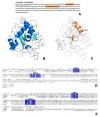3D Reconstruction of Hv RNASET2 Molecule to Understand Its Antibacterial Role
- PMID: 33352806
- PMCID: PMC7767213
- DOI: 10.3390/ijms21249722
3D Reconstruction of Hv RNASET2 Molecule to Understand Its Antibacterial Role
Abstract
Recent studies performed on the invertebrate model Hirudo verbana (medicinal leech) suggest that the T2 ribonucleic enzyme HvRNASET2 modulates the leech's innate immune response, promoting microbial agglutination and supporting phagocytic cells recruitment in challenged tissues. Indeed, following injection of both lipoteichoic acid (LTA) and Staphylococcus aureus in the leech body wall, HvRNASET2 is expressed by leech type I granulocytes and induces bacterial aggregation to aid macrophage phagocytosis. Here, we investigate the HvRNASET2 antimicrobial role, in particular assessing the effects on the Gram-negative bacteria Escherichia coli. For this purpose, starting from the three-dimensional molecule reconstruction and in silico analyses, the antibacterial activity was evaluated both in vitro and in vivo. The changes induced in treated bacteria, such as agglutination and alteration in wall integrity, were observed by means of light, transmission and scanning electron microscopy. Moreover, immunogold, AMPs (antimicrobial peptides) and lipopolysaccharide (LPS) binding assays were carried out to evaluate HvRNASET2 interaction with the microbial envelopes and the ensuing ability to affect microbial viability. Finally, in vivo experiments confirmed that HvRNASET2 promotes a more rapid phagocytosis of bacterial aggregates by macrophages, representing a novel molecule for counteracting pathogen infections and developing alternative solutions to improve human health.
Keywords: 3D reconstruction of HvRNASET2; LPS; antimicrobial activity; innate immunity; medicinal leech.
Conflict of interest statement
The authors declare no conflict of interest.
Figures







References
-
- Deshpande R.A., Shankar V. Ribonucleases from T2 family. Crit. Rev. Microbiol. 2002;28:79–122. - PubMed
MeSH terms
Substances
LinkOut - more resources
Full Text Sources
Medical

